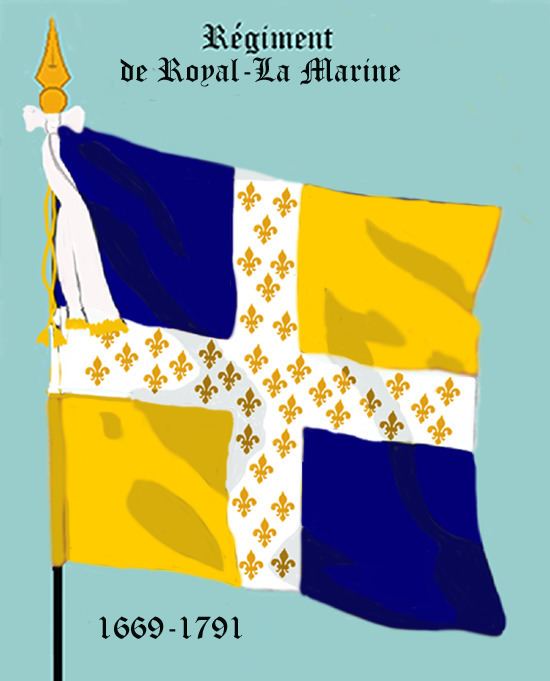Country France Type Regiment | Allegiance Kingdom of France Role Line Infantry | |
 | ||
Active 20 December 1669 – 21 March 1797 | ||
The Régiment Royal–La Marine was an infantry regiment of the Kingdom of France, established in 1669. The regiment was directly involved in the Day of the Tiles (French: Journée des Tuiles), which took place in Grenoble on June 7, 1788. The last unit of the regiment was incorporated into the 23 demi-brigade in March 21, 1797 and the regiment ceased to exist.
Contents
Lineage
Flags
Royal-La Marine Regiment had three flags: one "blanc Colonel" (white cross with golden fleur-de-lis), and two "drapeaux d'Ordonnance" (blue and auroras)
Uniforms
Colonels and Mestres de camp
Campaigns and battles
On December 1669, Colbert - who assumed command of naval (la marine) services after having nominated in November Louis de Bourbon, the legitimate heir of Louis XIV, aged only ten years, to the Admiralty of France - enacted an ordinance which created two regiments destined for naval service on the vessels and in the colonies. The regiments were designated « Royal-La Marine » and « Amiral ».
The regiment Royal-La Marine was attached to the Flotte du Ponant.
The Royal Navy (French: Marine royale) in need of quality marine offices, nominated the possibility of having naval officers of the two regiment as marine officers. In the same spirit on December 26 1669, was constituted, a « Garde de Monsieur l'Amiral » ( Guard of Monsieur Admiral ), even referred as « Garde de Monsieur le comte de Vermandois » ( Guard of Monsieur the Count of Vermandois ), which was created to become a crucible of marine officers.
With Louvois intervention, a new regulation of July 1670 passed the nomination of the officers of these two regiments - attached to the navy since creation - to the authority of the ministère de la Guerre, while also amending the possibility to pass naval officers to form the officers marine corps. Such a new regulation was the first passage of the "bigor" of the navy (French: Marine) to the French Army.
The only service at sea of these two regiments was brief. In August 1670, they embarked on the fleet of Duquesne on their way to the Canary Islands and Green Cape, and were back in Brest on March 11, 1671.
On August 13 1704, while through the decisive Battle of Blenheim (French: Höchstädt), during the War of the Spanish Succession (French: guerre de Succession d'Espagne), Le Royal-La Marine was part of the reserve army of maréchal Marsin, foreseen to support the Franco-Bavarian, placed under the command of Camille d'Hostun, duc de Tallard and Maximilian II Emanuel, Elector of Bavaria.
In 1720-1721, the regiment garrisoned at Souppes sur Loing (Seine et Marne) and participated to the construction of the canal du Loing.
On June 27 1743, the regiment participated to the Battle of Dettingen (French: bataille de Dettingen). The following year, the regiment participated to the Siege of Menin, the Siege of Ypres (1744) (French: Ypres) then Furnes, prior to joining the army of maréchal de Saxe at Courtrai.
From 1779 to 1782, the régiment Royal-La Marine participated to operations in Antilles
The 1st battalion of the 60th Line Infantry Regiment conducted the campaign of 1794 at the armée de l'Ouest (French: armée de l'Ouest); the 2e, embarked at La Rochelle in 1792 for Saint-Domingue, where garrison would be held until 1794.
